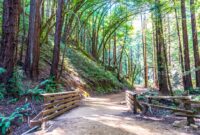Parks and trails near me offer a wealth of recreational opportunities, from leisurely strolls to challenging hikes. This exploration delves into the diverse motivations behind searches for nearby green spaces, examining the various user needs and preferences that drive this popular query. We’ll consider factors like accessibility, amenities, and the importance of accurate and comprehensive information for planning outdoor adventures.
Understanding user intent is crucial in designing effective search results. Different users seek different experiences; some might prioritize strenuous exercise while others seek family-friendly picnic spots. Geographical variations also play a significant role, influencing the types of parks and trails available and the information users require. By considering these factors, we can create a user-friendly experience that caters to a broad range of needs and expectations.
Locational Data & Search Results
Locating parks and trails efficiently relies on access to accurate and comprehensive locational data. This data, sourced from various providers, underpins the functionality of search engines and mapping applications dedicated to outdoor recreation. The quality of this data directly impacts the user experience, determining the accuracy of search results and the overall usefulness of the information provided.
Data Sources for Park and Trail Locations
Different data sources offer varying levels of accuracy and completeness regarding park and trail information. These sources can be categorized broadly into governmental, commercial, and crowdsourced datasets.
Governmental Data Sources
Governmental agencies at the local, regional, and national levels often maintain extensive databases of parks and recreational areas. These databases may include detailed information such as location coordinates (latitude and longitude), trail maps, accessibility information, and park amenities. Examples include data provided by national park services, state park agencies, and municipal recreation departments. Accuracy is generally high due to official surveying and maintenance, but completeness can vary depending on the agency’s resources and data updating practices. Some datasets might be incomplete or lack consistent formatting across different jurisdictions.
Commercial Data Sources
Commercial providers, such as mapping companies (e.g., Google Maps, Mapbox, OpenStreetMap), often integrate governmental data with user-generated content. They typically offer comprehensive coverage, incorporating various data points such as park boundaries, trail networks, and points of interest within parks. While generally accurate and comprehensive, commercial data sources may contain inaccuracies or inconsistencies due to the integration of various data sources and potential delays in updates. The level of detail may also vary depending on the specific provider and subscription level.
Crowdsourced Data Sources
Platforms like OpenStreetMap rely on user contributions to map and update geographical data, including parks and trails. This approach can lead to very detailed and localized information, especially in areas with less official data. However, accuracy and completeness are dependent on the number and reliability of contributors. Data quality can be inconsistent, and some areas might have limited or outdated information.
Organizing Park and Trail Information
A structured approach to organizing park and trail information is crucial for efficient data management and retrieval. A relational database model is well-suited for this purpose. This allows for the storage of various attributes related to each park and trail, facilitating flexible querying and analysis. Each park or trail could be represented as a record, with fields for attributes such as name, location coordinates, description, amenities, accessibility information, and user reviews. This structured format enables the creation of powerful search functions and data visualizations.
Sample Park Data
The following table displays sample park data, illustrating a structured format for organizing information. Distance is calculated from a hypothetical search location at coordinates 34.0522° N, 118.2437° W (near Los Angeles, CA).
| Name | Location (Latitude, Longitude) | Features | Distance from Search Location (miles) |
|---|---|---|---|
| Griffith Park | 34.1139° N, 118.3001° W | Hiking trails, Observatory, Zoo | 7 |
| Runyon Canyon Park | 34.1018° N, 118.3251° W | Hiking trails, City views | 5 |
| Elysian Park | 34.0781° N, 118.2402° W | Hiking trails, Baseball field | 1 |
| Baldwin Park | 34.0872° N, 118.0166° W | Picnic areas, Sports fields | 18 |
User Experience & Information Presentation
A positive user experience is paramount for any park and trail finder application. Clear, concise, and easily accessible information is crucial for users to quickly find the parks and trails that best suit their needs and preferences. Poorly presented information can lead to frustration and ultimately, a negative user experience, driving users away from the application.
Effective information presentation significantly impacts user engagement and satisfaction. This involves careful consideration of how information is structured, formatted, and visually represented to ensure it’s readily understandable and enjoyable to interact with. Key elements include intuitive navigation, easily digestible text, and visually appealing map integrations.
Map Representation of Park Locations
Visually representing park locations on a map utilizes a geographic information system (GIS) approach. Interactive maps allow users to easily locate parks and trails within a specified area. Markers, ideally custom icons representing different park types (e.g., a tent for campgrounds, a hiking boot for trails), pinpoint locations. Users should be able to zoom in and out, pan across the map, and potentially use different map views (satellite, street, terrain). Clicking on a marker should provide a brief overview of the park, including its name and a link to the detailed information page. Consider incorporating a legend to explain the different marker icons. For example, a green pin might indicate a park with easy trails, while a blue pin might signify a park with water features.
Sample Park Description
Nestled amidst towering redwoods and overlooking a tranquil lake, Redwood Glen Park offers a serene escape from city life. The crisp air carries the scent of pine and damp earth, while sunlight filters through the dense canopy, dappling the forest floor. Meandering trails wind through the grove, perfect for leisurely strolls or invigorating hikes. A picnic area with shaded benches provides an ideal spot for a relaxing lunch, and the clear waters of the lake beckon for a refreshing swim or a peaceful moment of reflection. The park also boasts a charming wooden bridge spanning a babbling brook, adding to its rustic charm.
User Review and Rating Display
A user interface element for displaying user reviews and ratings could be a section dedicated to “Community Reviews” located beneath the park’s description. This section would feature a star rating system (e.g., 1 to 5 stars) prominently displayed, followed by a summary of the average rating. Individual reviews would be presented chronologically, each including a user’s name (or a username), the date of the review, and the star rating they gave. Each review text would be concise and easily readable. A “Read More” button could expand longer reviews. A filtering option (e.g., sorting by rating, date, or relevance) would further enhance usability. Consider incorporating a system to report inappropriate or abusive reviews. This could include a simple “Report” button beside each review.
Summary
Finding the perfect park or trail nearby is now easier than ever, thanks to readily available online resources and increasingly detailed mapping tools. By focusing on user needs, accurate data, and intuitive information presentation, we can enhance the discovery and enjoyment of these valuable community assets. Whether you’re seeking a quiet retreat or an active adventure, the information provided empowers you to plan your next outdoor escape with confidence.




